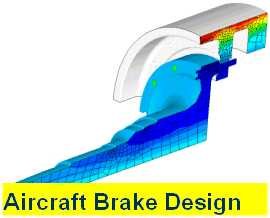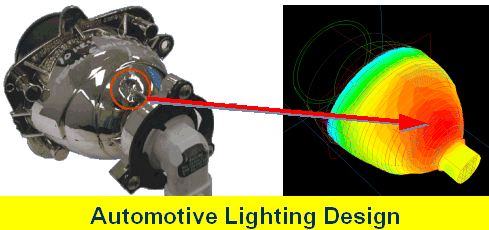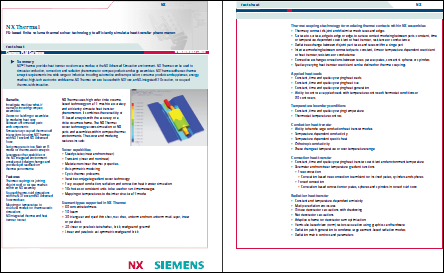
NX
TMG Thermal
for ![]() Advanced Simulation environment solves engineering heat transfer problems
within the most complex NX assemblies.
Advanced Simulation environment solves engineering heat transfer problems
within the most complex NX assemblies.
![]() NX
TMG Thermal
combines the versatility of FE-based modeling with the accuracy of a
finite-difference solver. The high order finite volume simulations offer fast
and high fidelity numerical predictions of radiation, conduction and convection
heat transfer problems. NX TMG Thermal can also be coupled seamlessly to NX
Flow,
the NX CFD solution, for coupled thermo-fluid simulation.
NX
TMG Thermal
combines the versatility of FE-based modeling with the accuracy of a
finite-difference solver. The high order finite volume simulations offer fast
and high fidelity numerical predictions of radiation, conduction and convection
heat transfer problems. NX TMG Thermal can also be coupled seamlessly to NX
Flow,
the NX CFD solution, for coupled thermo-fluid simulation.



![]() NX
Thermal Couplings
provide a powerful and efficient capability for modeling heat flow between
unconnected parts and components.
NX
Thermal Couplings
provide a powerful and efficient capability for modeling heat flow between
unconnected parts and components.
Multiple "what-if" scenarios and positioning of parts within an assembly can be investigated by defining thermal coupling parameters between unconnected parts once. Thermal coupling types include conductive, radiative, convective and interface couplings.
Thermal couplings can be defined as varying within model parameters, such as temperature or heat load. All heat paths between unconnected parts are created at runtime automatically.
- Steady-state and transient (linear and nonlinear).
- Fully coupled conduction, radiation and convection heat transfer simulation.
- Iterative conjugate gradient solver technology.
- Efficient time stepping and other advanced transient algorithms.
- Diffuse view (form) factor calculations with shadowing.
- Hemicube-based view factor calculation (using graphics card hardware).
- Material non-linear thermal properties.
- Axis-symmetric modeling.
- Cyclic thermal problems.
![]() Thermal
Couplings technology for modeling thermal contacts within NX assemblies:
Thermal
Couplings technology for modeling thermal contacts within NX assemblies:
- Thermally connect disjoint and dissimilar mesh faces and edges.
- Surface-to-surface, edge-to-edge or edge-to-surface contact modeling between parts: constant, time or temperature-dependent coefficient of heat transfer, resistance or conductance.
- Radiative exchange between disjoint part faces (or faces within a single part).
- Interface modeling between connected parts: constant, time or temperature-dependent coefficient of heat transfer, resistance or conductance.
![]() Applied
heat loads:
Applied
heat loads:
- Constant
and time-dependent:
- Heat loads.
- Heat flux.
- Heat generation.
- All applied loads can be controlled with temperature-controlled thermostat conditions.
![]() Temperature
boundary conditions:
Temperature
boundary conditions:
- Constant temperature for steady-state or transient.
- Time varying for transient and for nonlinear steady-state.
- Thermostat temperature controls.
![]() Conduction
heat transfer:
Conduction
heat transfer:
- Handles large conduction models (memory efficient data scheme).
- Temperature-dependent conductivity, specific heat.
- Orthotropic conductivity.
- Heat of formation at phase change temperature.
![]() Convection
heat transfer:
Convection
heat transfer:
- Constant, time and temperature-dependent heat transfer coefficients
- Parameter and nonlinear temperature gradient functions
![]() Radiation
heat transfer:
Radiation
heat transfer:
- Constant and temperature-dependent emissivity.
- Multiple radiation enclosures.
- Diffuse view (form) factor calculations with shadowing.
- Net view (form) factor calculations.
- Adaptive scheme for view (form) factor sum optimization.
- Hemicube-based view (form) factors calculation using graphics card hardware.
- Radiation patch generation to condense large element-based radiation models.
- Radiation matrix controls and parameters.
![]() Initial
conditions:
Initial
conditions:
- Starting temperatures for both steady-state and transient runs.
- Starting temperatures from previous solution results, or from file.
![]() Solver
solution attributes
Solver
solution attributes
- Restart conditions
- Cyclic convergence criteria
- Direct access to solver parameters
- Solver convergence criteria and relaxation factors
- Solver monitor with solution convergence and attributes
- Intermediate results display and recovery directly from solver progress monitor
![]() NX
results post-processing
NX
results post-processing
- Temperature.
- Temperature gradient.
- Total load and flux.
- Conductive flux.
- Convective flux.
- Convection coefficient.
- Residual.
- View factor sum.
![]() NX
Thermal specific post-processing features
NX
Thermal specific post-processing features
- Results Reporter.
- Summary of results to Excel worksheets.
- Heat flow calculation between groups.
- Heat maps.
- Complete or partial deactivation of selected elements (for radiation form factors calculations).
- Temperature mapping for Nastran and other FE models.
